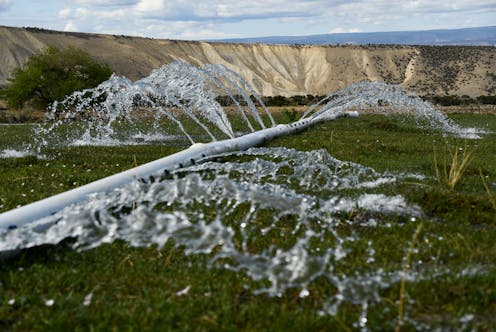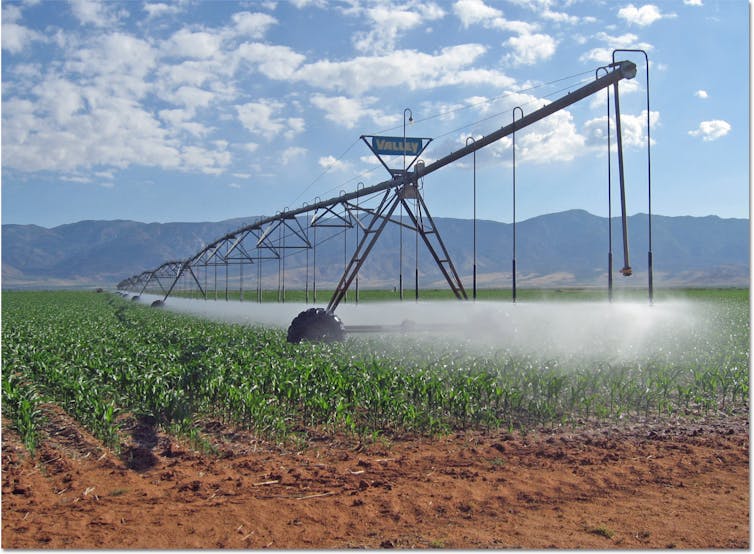
“Are you going to run out of water?” is the first question people ask when they find out I’m from Arizona. The answer is that some people already have, others soon may and it’s going to get much worse without dramatic changes.
Unsustainable water practices, drought and climate change are causing this crisis across the U.S. Southwest. States are drawing less water from the Colorado River, which supplies water to 40 million people. But levels in Lake Mead and Lake Powell, the river’s two largest reservoirs, have dropped so low so quickly that there is a serious risk of one or both soon hitting “dead pool,” a level when no water flows out of the dams.
On June 14, 2022, U.S. Bureau of Reclamation Commissioner Camille Calimlim Touton warned Congress that the seven Colorado River Basin States – Arizona, California, Colorado, Nevada, New Mexico, Utah and Wyoming – need to reduce their diversions from the Colorado River by 2 million to 4 million acre-feet in 2022. An acre-foot is enough water to cover an acre of land, about the size of a football field, with a foot of water – roughly 325,000 gallons. If the states don’t come up with a plan by August 2022, Touton may do it for them.
To achieve Touton’s objective, states need to focus on the region’s biggest water user: agriculture. Farmers consume 80% of the water used in the Colorado River Basin. As a longtime analyst of western water policy, I believe that solving this crisis will require a major intervention to help farmers use less water.
Lawns in the desert
It’s not an exaggeration to call the Southwest’s water shortage a crisis. Declining river levels are compromising electricity generation from hydropower, which affects the power supply for millions of people. Farmers are fallowing fields and using less water on their crops. This, in turn, imperils food production already under global strain from the war in Ukraine. Drought conditions could wipe out endangered species, especially salmon.
There is something profoundly unsettling about the lush green landscape in Southern California, a desert transformed by the power of water. The average annual rainfall at Los Angeles International Airport from 1944 to 2020 was 11.72 inches (30 centimeters). That’s not much more than Tucson, Arizona, gets in the middle of the Sonoran Desert.
Now, however, western states are imposing unprecedented restrictions on water use. On June 1, 2022, the Metropolitan Water District, wholesaler to 20 million Southern Californians, urgently called for a 35% reduction in water use. In response, the Los Angeles Department of Water & Power is limiting residents to watering their lawns twice a week, for eight minutes per session. Other providers allow just one weekly watering.
The California Water Resources Control Board has ordered many farmers and San Francisco Bay-area cities to stop diverting water from the San Joaquin River system. Golf course operators are under substantial pressure to reduce water use.
Focus on irrigation
Still, agriculture uses far more water than lawns and golf courses. In 2017, U.S. farmers irrigated about 58 million acres (23 million hectares) of cropland, almost two-thirds of it in the West.
In recent decades western farmers have significantly changed their irrigation practices. Many have switched from flood systems, which literally flood fields, to pressurized systems. Typically these are center pivots that apply water from sprinklers connected to a large arm that slowly moves around a core, creating those large, usually green circles that airplane passengers can see across the West. This shift reduces water losses from evaporation, percolation into the soil and runoff.
In 2012, U.S. farmers used pressurized systems on 72% of their fields, up from 37% in 1984. That still leaves 28%, or 20 million acres (8 million hectares), that are flood irrigated.
And center-pivot systems are not as efficient as drip or microirrigation, which delivers water directly to plants’ root zone through hoses embedded in the soil. Drip irrigation delivers water slowly, reducing runoff and evaporation. Microirrigation systems use 20% to 50% less water than conventional sprinkler systems.

But drip systems are quite expensive, costing upwards of US$2,000 per acre. They are not cost-effective for farmers who grow low-value crops, such as alfalfa, and are prohibitively expensive for small farmers.
Most farms that irrigate are small operations with fewer than 50 acres (20 hectares) and less than $150,000 in annual revenues. But large-scale farms, with annual revenues over $1 million, use about 60% of irrigated water.
Bigger farms have the necessary capital to invest in sprinkler systems, but not necessarily enough to invest in highly efficient subsurface drip or microirrigation. Existing U.S. Department of Agriculture programs offer modest incentives, usually a maximum of $100 per acre – not enough to justify switching for most farmers.
Balancing rural and urban needs
Helping farmers switch to high-efficiency irrigation systems would benefit the entire Southwest. I propose a two-pronged approach.
First, Congress would provide funding to the U.S. Department of Agriculture to offer farmers more generous financial incentives to switch to microirrigation systems. The 2021 infrastructure bill contains $8.3 billion to assist western states in adapting to drought and climate change. I believe that this financial aid, with support from the federal Bureau of Reclamation and the USDA, could persuade millions of American farmers to make the move.
Second, to augment the federal program, state, municipal and local interests, including government agencies and private businesses, would create funds to underwrite the entire cost of converting farms to microirrigation. As I envision it, cities could offer to absorb 100% of the purchase and installation costs of microsystems in exchange for a percentage of the water that farmers would save by making the switch.
A program that’s cost-free to farmers would be far more attractive than existing federal programs. In my view, locally financed programs managed in collaboration with farm communities could reallocate a lot of water in a short time frame. This could be done through either a formal water rights transfer or short- or medium-term leases with farmers retaining water rights.
In the past, farmers have been rightly suspicious when city representatives arrived with proposals to buy agricultural water. All too often, such transfers have triggered economic death spirals for rural communities. But it need not be so.
Because farmers consume about 80% of western water, while residential, commercial and industrial use is less than 10%, I believe reducing agricultural consumption by a few percentage points would solve the municipal and industrial need for water. If farmers achieve this reduction thanks to increased efficiencies from microirrigation systems – paid for by cities – the farmers could grow as much product as they do now, with slightly less water.
Making this shift could raise economic and technical challenges. For example, most farms would probably fallow or reduce production of low-value crops, such as alfalfa, which could affect animal feed prices. And one disadvantage of drip irrigation systems is that gophers love to gnaw on the plastic tubes, so farmers would need an animal control program.
Nonetheless, I see voluntary, compensated water transfers as a strategy that would protect the long-term viability of rural communities and keep the taps flowing in western cities. Limits on watering lawns won’t solve the West’s water crisis.
Robert Glennon does not work for, consult, own shares in or receive funding from any company or organisation that would benefit from this article, and has disclosed no relevant affiliations beyond their academic appointment.
This article was originally published on The Conversation. Read the original article.







